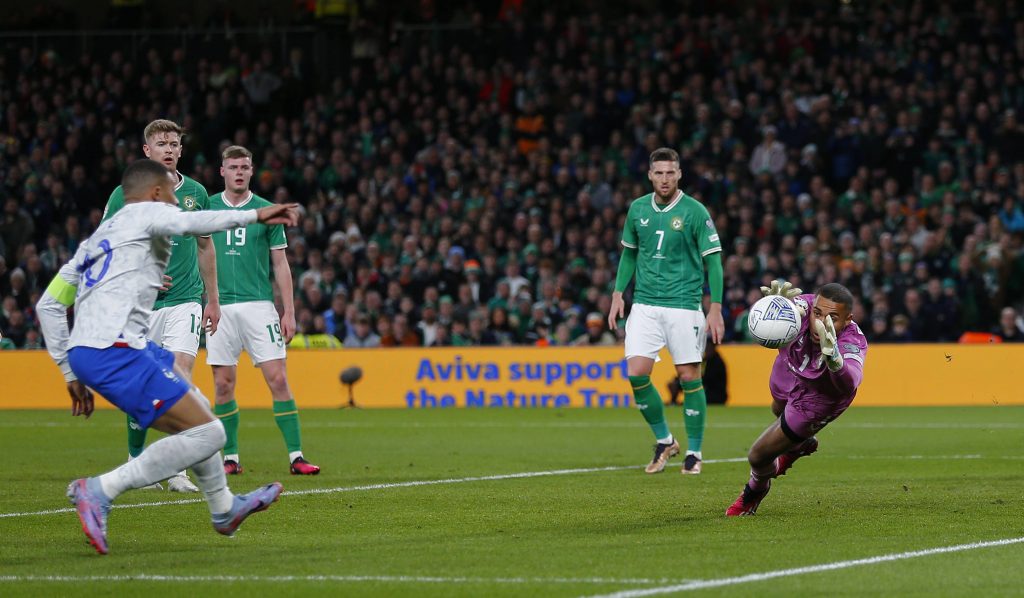Andy Watson examines Great Britain’s closest neighbour and how GBE has affected the market across the Irish sea
Reports emerged recently of Newcastle United signing the bright Irish talent Reece Byrne from Bohemians. The 18-year-old has one senior appearance for the famous Dublin club but is a regular age group goalkeeper for his country. Reports suggest that Byrne will go into the Newcastle Academy set-up to compete with other highly rated goalkeepers in the system.
Meanwhile, at the other end of the country, a couple of young Irishmen have already emerged on the Premier League scene this season. Gavin Bazunu has played an enormous number of minutes as Southampton’s #1 goalkeeper, and just 90km east, Evan Ferguson has broken into the exceptionally impressive Brighton team under Roberto De Zerbi and is now their first choice centre forward at just 18 years old.
The future does look bright for Ireland as a football nation in general after a few years in the doldrums. The gradual break-up of the national team that qualified fairly consistently for major tournaments over a decade ago left behind something of a talent void. However, Bazunu and Ferguson are a couple of the young guns that are threatening to bring the Irish national team back into the qualification picture.
The good news for the country is that the talent seems to run deep as well: the Irish U17 team have already qualified for the summer’s Euro finals, a rare feat for the country’s youth teams.
The gaze of recruitment departments in the English Football League has been drawn to the Irish league of late, with many of them looking to replicate the likes of Bazunu and Ferguson’s success for their own clubs.
This article will assess the current situation in Irish recruitment, investigate the root causes for the changes, and speculate as to what this could mean for the League of Ireland’s relationship with English clubs in the future.
What is the current landscape?
To ascertain what is happening in the League of Ireland Premier Division and the business conducted with the English clubs, and why it is happening, it is beneficial to lay out the exact situation.
First of all, it should be stated that the League of Ireland run their football season in the summer months. The seasons used in this study though relate to the English football seasons, so, for example, transfers conducted in the summer of 2022 would relate to the 2022/23 season.
To begin with, let us observe the number of players that have made the move from the League of Ireland Premier Division to an English league club (ruling out non-league transfers) over the last ten seasons.
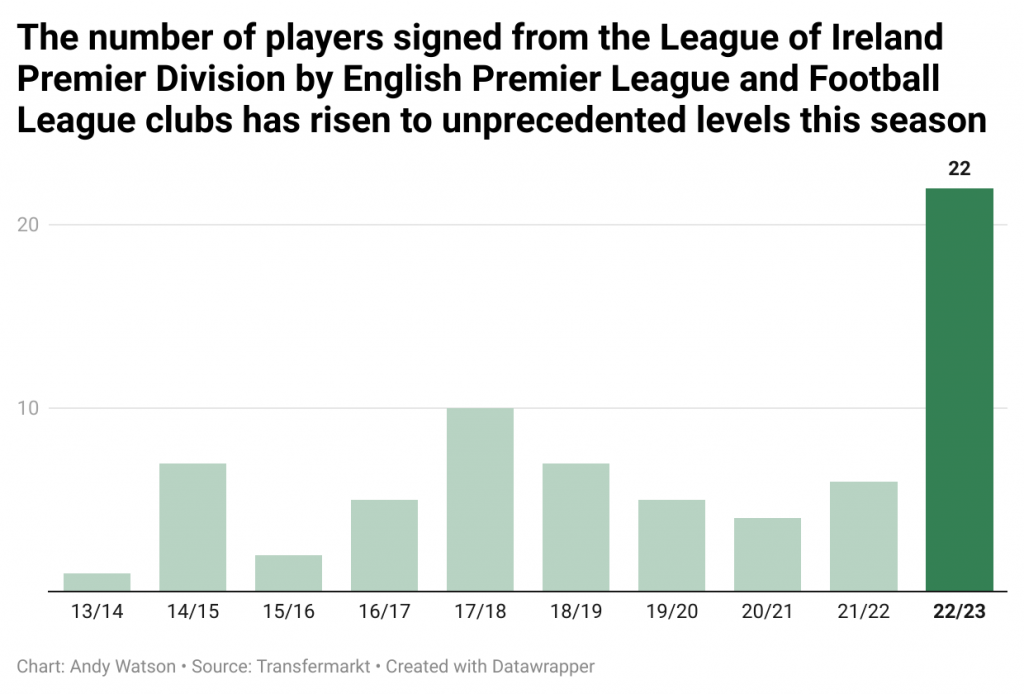
The numbers here are quite stark. This season has seen more than double the previous high of 10 players in 2017/18. Indeed, this season represents a 367% increase on LoI Premier Division to English League transfers.
The amount of money that this represents to the League of Ireland clubs is not that easy to ascertain. There are 10 transfers in the cohort of 22 that came with an undisclosed fee, but the fees that have been disclosed are close to 1m euro. Historically, those fees are on a par with what was spent in the division by English clubs in 2018/19. Half of that money was spent on Gavin Bazunu by Manchester City when Bazunu was just 16.
The amount of money spent by English clubs in the LoI Premier League is quite sporadic and also, not enormous relative to other leagues. For there to have been no year in the last decade in which a million pounds is spent in total (although undisclosed fees mean that it probably has gone over a million) makes the league something of an outlier for ones involved in regular transfer business.
We can go a little more into depth and find out what this explosion looks like. These are the 2022/23 transfers broken down by individual:
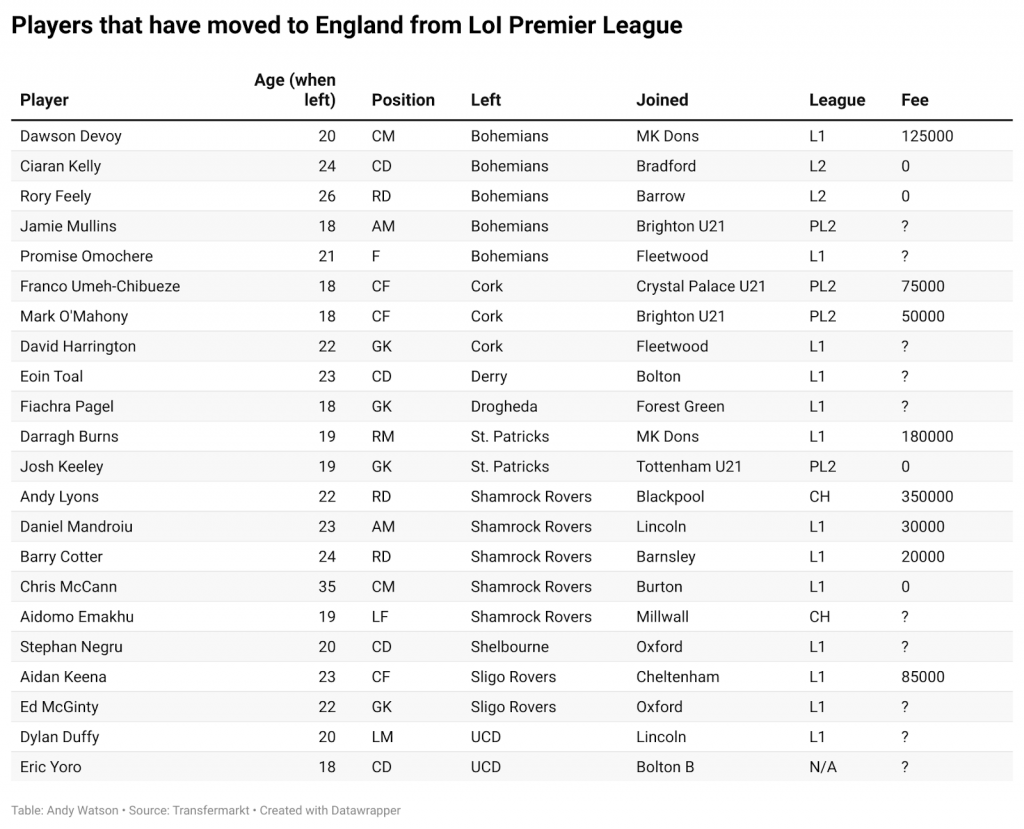
There are a couple of obvious and interesting takeaways from looking at the players sold here.
Firstly, nine out of the 10 Irish clubs have lost a player to England, with Dundalk the only omission. That doesn’t mean that there has been in any way an even split though; Bohemians and Shamrock Rovers account for almost half of the sales between them. Rovers’ UEFA competition experience probably helping raise the profile of both the club and some of their talented players.
Secondly, the average age of the players leaving is quite young, with 21.45 the mean age. This is not unusual, of course, especially when buying clubs have half an eye on resale value and buying potential. Also, with the cases of Bazunu and Ferguson a possible model, it seems as though clubs may be establishing a pattern of investing in young Irish players. There is one major difference, though: none of the players are under the age of 18. We will come to the reason for this in due course.
However, it is worth noting that the lower the league of the purchasing club in England, the less that a young profile seems to matter. The players that moved directly into League Two, Ciaran Kelly and Rory Feely, are of an age where they are established first team players, and have been for a few seasons. This means that they can be relied upon to be physically, mentally, tactically and, hopefully, emotionally, ready to go for their new clubs straight away.
Another obvious point, but one that we will delve further into, is that the destination for a lot of these Irish players is League One. Thirteen of the 22 players that left the LoI Premier Division did so to go to League One. Two more went to League 2, two into the Championship, and five into U21 or B teams. It was the U21 route that Bazunu and Ferguson took.
The way that this has mapped out in 2022/23 suggests that League One clubs have latched onto the Irish market in a big way. The question is, why? And why now?
To answer this, we can look at League One, where there has definitely been a change in the way the Irish market is viewed.
Of the 45 transfers that were conducted in the decade prior to 22/23, only 27% of those players went into League One, with the Championship taking more players from the league in that period.
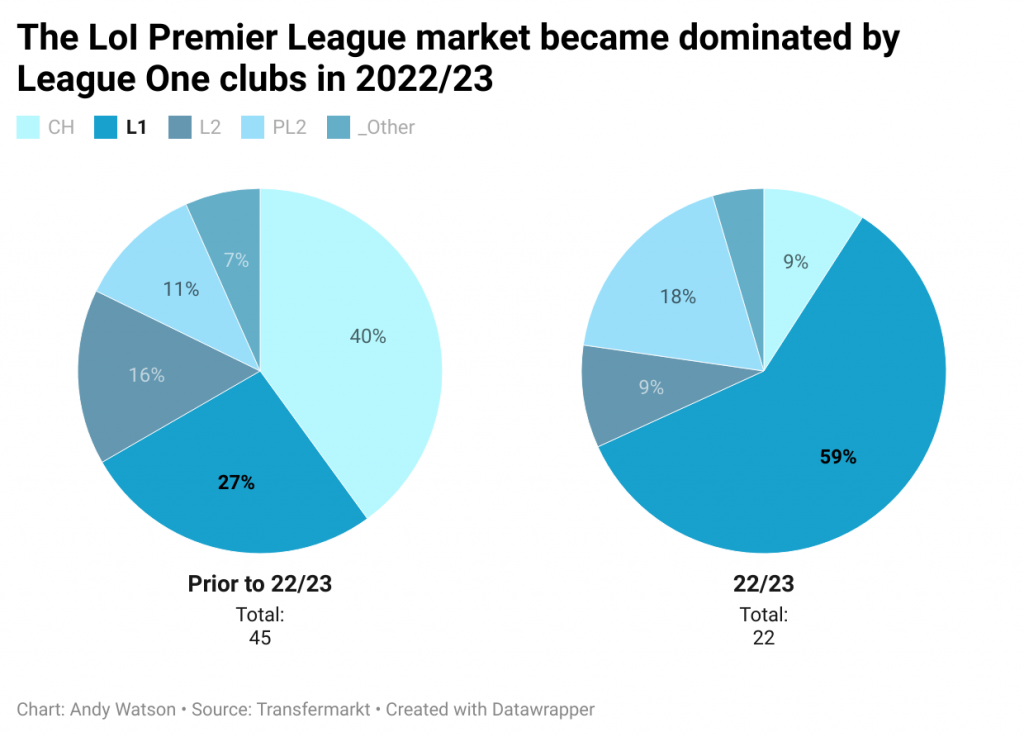
As the graphic shows, League One has dominated the market in the last season.
We can also observe what this has meant overall in terms of the share that the LoI Premier League players have in terms of the transfers into League One.
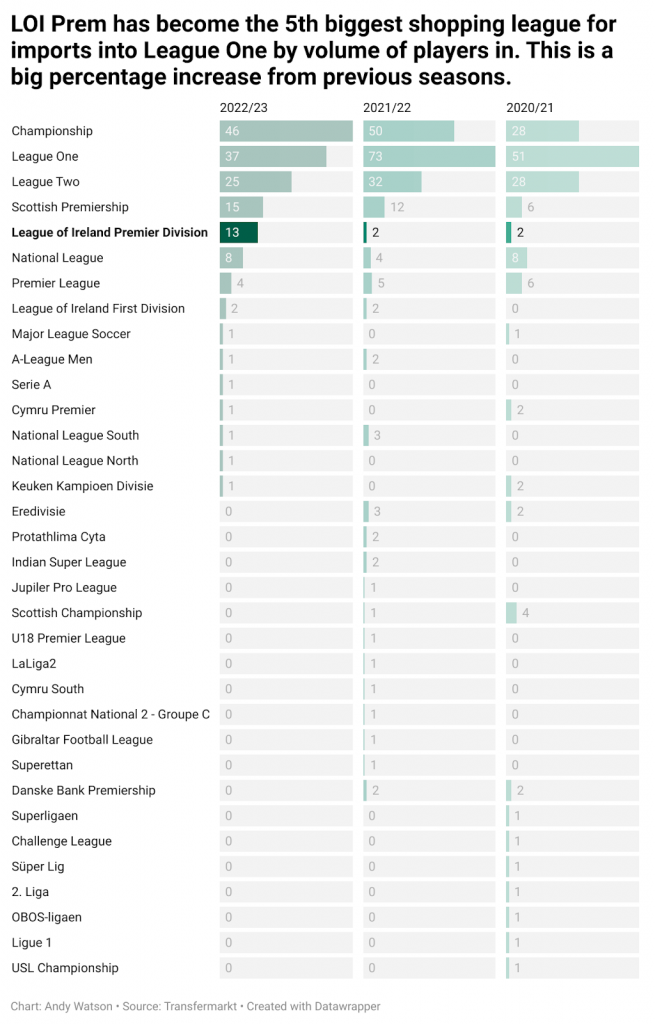
If this season is a precursor to either further growth or a solidity of the Irish share of the market then the LoI Premier League will challenge the Scottish Premiership for the biggest source of players for League One outside of the domestic league system.
Fees have started to be spent in Ireland by League One clubs as well. This hasn’t historically been the case, though it has been for the Scottish Premiership. Are some fees which would have traditionally gone north of the border now go across the Irish Sea instead?

A greater sample size is definitely required to answer that question, but from conversations within the recruitment fraternity it would not be a surprise for that to be the case.
Joe Riley, Head of Recruitment for Fleetwood Town, a League One club who have used the Irish market to bring in Promise Omochere, David Harrington, and Phoenix Patterson (from second tier Waterford FC), was able to give some insight from his perspective on this.
“LOI is a market we will look at because historically it’s produced a good number of players that have done well in the EFL,” said Riley. “What you do find about LOI is that it is a robust league, very competitive, and generally the players have a desire and a competitive edge to them which are traits that we look for.”
When discussing the specific example of Promise Omochere, Riley is happy to explain how the youngster was spotted. “Omochere caught my eye the first game i seen him. A 22 year old powerful 6ft3 striker – there are not many around”, said Riley. “He was coming from a part time programme with Bohemians so when I watched him he had attributes that would succeed over here physically but also had attributes that could be improved in a full time environment, especially given the training ground we have.”
“Promise has needed time to adjust and get used to a full time environment and intensity of it, and we did plan for him to be given that time but everyone is seeing improvements in him. A great attitude with a willingness to keep getting better doesn’t come often in players but the due diligence we did on him when signing all told us that he has exactly that.”
It has long been the case that physical attributes are of great importance when looking for players to have an impact in the EFL, so perhaps it makes sense that Ireland might a good source of this type of player as opposed to, perhaps, bottom end of Eredivisie or Belgian League players.
Where does Brexit come into this?
Ireland has a unique relationship with British clubs post-Brexit. Although players from the rest of the world are now subject to GBE regulations, Irish players who are over 18 are exempt due to a pre-existing, and therefore superseding, arrangement, the Common Travel Area. The 2021 GBE Rules clarify that they are applicable to “any player who is not a citizen of the UK or Ireland”, except when those players are under 18. This obviously means that Ireland not only remains of interest to English (and Scottish, Welsh, and Northern Irish) clubs, but also that the market has perhaps become more interesting comparatively, because of the relative ease of arranging transfers for senior players.
And, as shown in Analytics FC’s Brexitball report of 2022, the pool of players that English clubs have to shop in has reduced significantly to around 5,000-7,000 players worldwide. This means that the 300-400 players in Ireland represent a significant proportion of the total and this is probably part of the reason why a greater focus has been placed upon them.
Joe Riley backs this up. When asked about why the emphasis on Ireland seems to have come about, he had one main reason: “It is more than likely due to Brexit. Generally, young Irish players want to come over to England and succeed. And, given our multi-club ownership (Waterford) it is a market that we will continue to look into. I expect our recruitment competitors to do the same given recent successful stories that have come from the league [such as] Luke McNally.”
Riley mentions Brexit, but how does it actually have an effect here for League One clubs? Unlike the Premier League and, especially The Championship, this isn’t a direct case of Irish players now being purchased in lieu of not being able to any longer buy players due to Brexit. This is because, traditionally, League One clubs did not tend to bring players in from Europe anyway. So what does Brexit have to do with it?
The changes that were made in December 2020 by the FA have obviously been well documented in the Brexitball series to date. The bits of the legislation that really apply here are about the registration of players. Though FIFA have had regulations around the transfer of players under the age of 18 for some time, i.e. a player under the age of 18 cannot be transferred from one country to another, European Union freedom of movement meant that this didn’t necessarily apply for players in the EU.
Of course, this meant that English clubs were allowed to purchase players from the age of 16 from anywhere in the EU, including Ireland. It was initially thought that as a result of the CTA relationship between Ireland and England that there was a chance that that clause could continue, but Evan Ferguson’s transfer in the first few days of January 2021, only made possible by the fact that Ferguson’s mother is English, is the last example of a under-18 moving from the LoI Premier Division to England in the records.
What this means, though, is that as a result of the change to the age that players can leave Ireland for England, many of the top talents in Ireland are actually getting more first-team exposure in the LoI Premier Division.
This is having the effect of improving the standard of the league itself as there are generally better players playing in the competition, and also, players are better prepared to move to England having had more first-team experience, and, indeed, life experience, than previously.
The added European exposure for the top Irish teams is having an effect as well. Shamrock Rovers, St. Pat’s, and Sligo Rovers all enjoyed European adventures this season, which has the effect of bringing more money into the league, giving players greater experience, and therefore, raising the profile of the league and making it more attractive for investment.
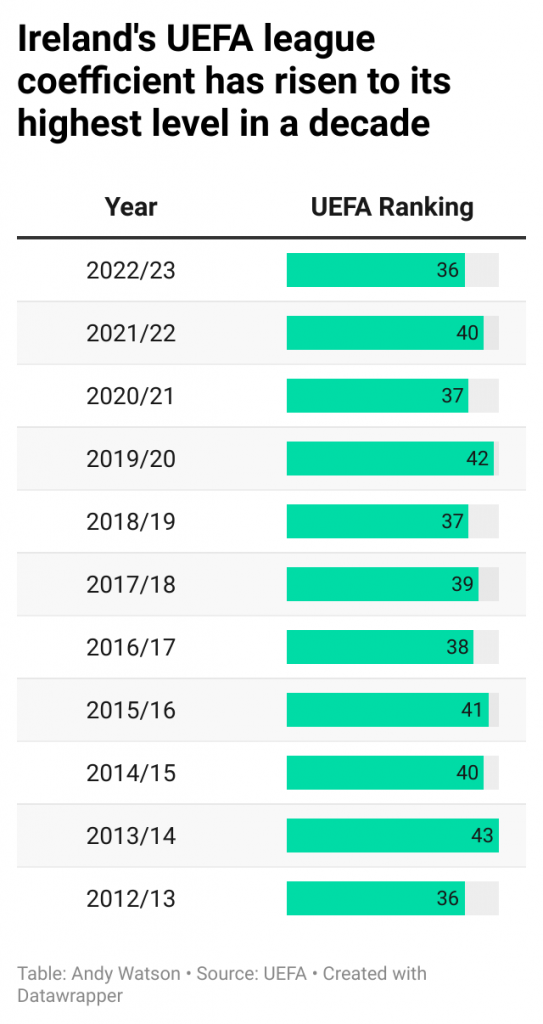
This is interesting because, as we have seen, there has been a recent tendency towards League One clubs establishing themselves in this market. One possible argument is that previously, the top tier young talent was being plucked at an early age by Championship and Premier League sides, leaving a less robust league in Ireland. This, in turn, meant that the talent pool was more shallow but also, crucially, that those good Irish youngsters who did not make the grade in the top two tiers could eventually percolate down to League One or Two from an English club.
Now, clubs with bigger budgets, where gambling on a return is less of an issue, are less able to speculate on youth talent, while players who grow and develop in a slightly stronger LoI are more ready to move to a lower level in England than perhaps might have been the case. It’s hard to know for sure, but there is certainly some merit to this argument.
Do Irish transfers to England pay off?
Looking back at transfers from the LoI Premier League into England before this season shows a mixed bag, despite Riley mentioning some Irish successes.

Looking into each transfer from the last five years paints a picture of many players not making an impact. The mean number of percentage of minutes played for the actual purchasing club (not including loan spells away) sits at less than 20%. Whilst amount of time on the pitch doesn’t necessarily equate to the success, or not, of a transfer, it does serve to highlight the difficulties found in dealing in this market in the recent past.
Joe Riley is correct to point to the success of Luke McNally though. The central defender was bought at 22 by Oxford United in League One and after one season of 80% minutes on the pitch was turned over by the Yellows for an approximate £1.5m profit. This is clearly a model worth trying to replicate for other League One clubs and may have had an impact towards what we have seen in terms of the explosion observed above. Ronan Curtis, Sean Maguire, and Sean McLaughlin have also been successful transfers for League One level or above.
However, there are plenty of warning signs here. Almost half of the players never played more than a token number of minutes for their purchasing club. Chiedozie Ogbene and Warren O’Hora did eventually establish themselves in League One with different clubs, and Killian Phillips looks as though he has a future at League One or above, but many of these players never made it. It is worth noting that the most successful LoI transfer of recent times, Gavin Bazunu, is also in the 0% cohort because he never took to the field for Manchester City.
On that note, let us look at return on investment in terms of monetary value. Part of the real value of shopping in Ireland is the comparatively low fees paid for their top players. Obviously, many have come across on frees, and, frustratingly, there are a number on undisclosed fees as well, which obfuscates the analysis somewhat.
However, looking at transfers from the last five years, excluding the current season, an interesting picture emerges.
Of the 30 players in this cohort, 11 are still with their purchasing club. Of the 19 that have moved on, eight were sold for a cash value. Five of these were undisclosed, but looking at the clubs involved, would have probably been for small amounts. The three main “sell-ons” were the aforementioned Luke McNally, Warren O’Hora, and Gavin Bazunu.
In terms of forming a trend, all three of those cases tell a story. McNally is the poster-boy for League One clubs looking to player trade successfully. O’Hora is a typical speculation for a Premier League side with a budget for developing interesting talent in the hope that they can graduate to their first team, and if not, can make no loss on the speculation by selling for a small fee into the professional leagues below.
Bazunu, one of the inspirations for the whole article, is the poster-boy for now a by-gone age, the opportunity that Brexit has now closed the door on. He was plucked from Shamrock Rovers at a young age, albeit for a fee that dwarfs anything else in the sample, but less than pocket change for Manchester City. Bazunu was intelligently loaned out into League Two and League One before Southampton were so convinced of his ability they were comfortable enough to shell out 14 million Euros for them to make him their number one in the Premier League. This saw a return-on-investment of 2800% for Manchester City, and earning Shamrock Rovers an extra 3 million Euro into the bargain.
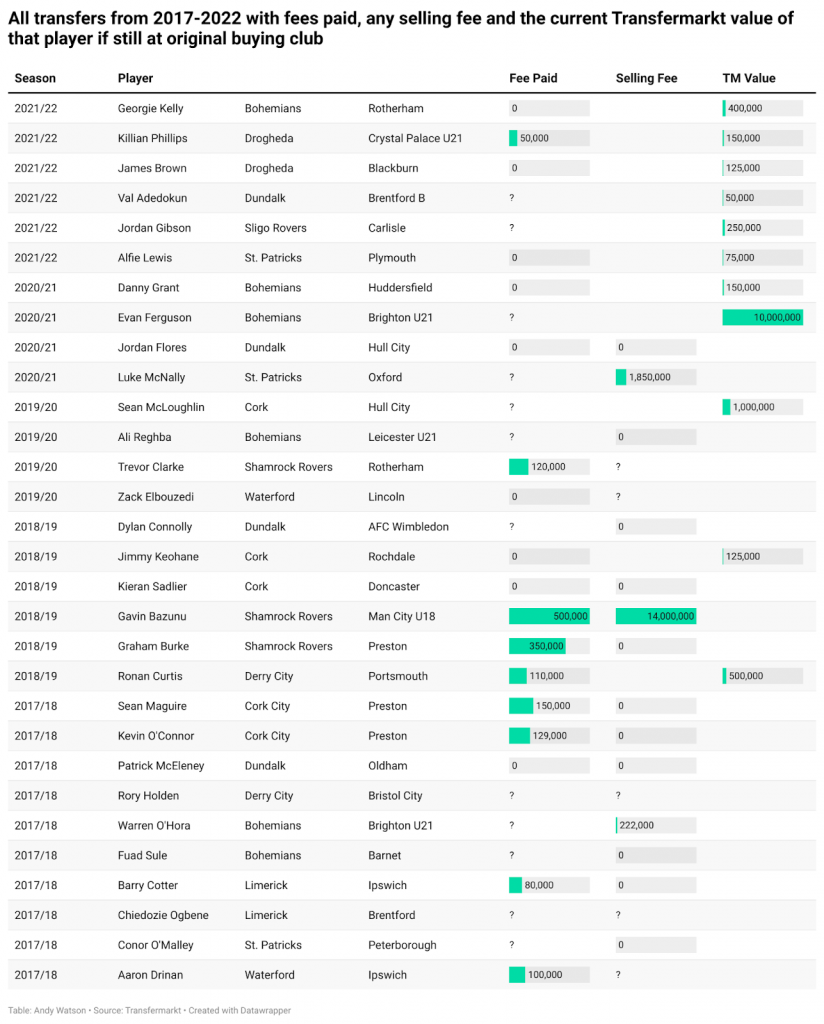
Looking at the picture as a whole though, those three examples are the exception rather than the rule. The question, then, is is it worth the speculation?
Each McNally or Bazunu pays for many darts to lob at recreating that success. So Oxford and Man City can afford to renew this model; however, should Ipswich have kept going after Barry Cotter and Aaron Drinan didn’t work for them?
This is obviously hard to answer, but there are probably enough successes to merit a consistent approach. Of players that haven’t yet left their original purchasing clubs, Evan Ferguson is again the poster boy. This is perhaps what happens when you persist with a model, if a Warren O’Hora doesn’t necessarily work out for Brighton, then an Evan Ferguson may well do. He is currently worth 10 million Euro according to Transfermarkt, though, in reality, in the current market, you could probably multiply that by a fair number (especially given his joint nationality status).
Ronan Curtis and Sean McLoughlin have given years of service to their clubs and are still worth more than they were bought for if a sale was to come for either. Jordan Gibson looks to be in a similar mould after a great season for Carlisle, Georgie Kelly is a definite asset for Rotherham, and Killian Phillips looks a potential ‘develop and sell’ for Palace.
There are definitely reasons in that recent transfer cohort to see why the Irish market has been targeted, but also lots of warning signs to be heeded as well. As with any transfer strategy, the keys are (mostly) money, but also developing systems (such as affiliate clubs or MCO models, or relationships with local scouts) that make a good return more likely, as well as leveraging data intelligently.
This season: assessment and conclusion
It is still very early days for most of the signings from the 2022/23 season, especially those in January but, on the other hand, Luke McNally was flipped by Oxford after one season. So how are the recent signings faring?
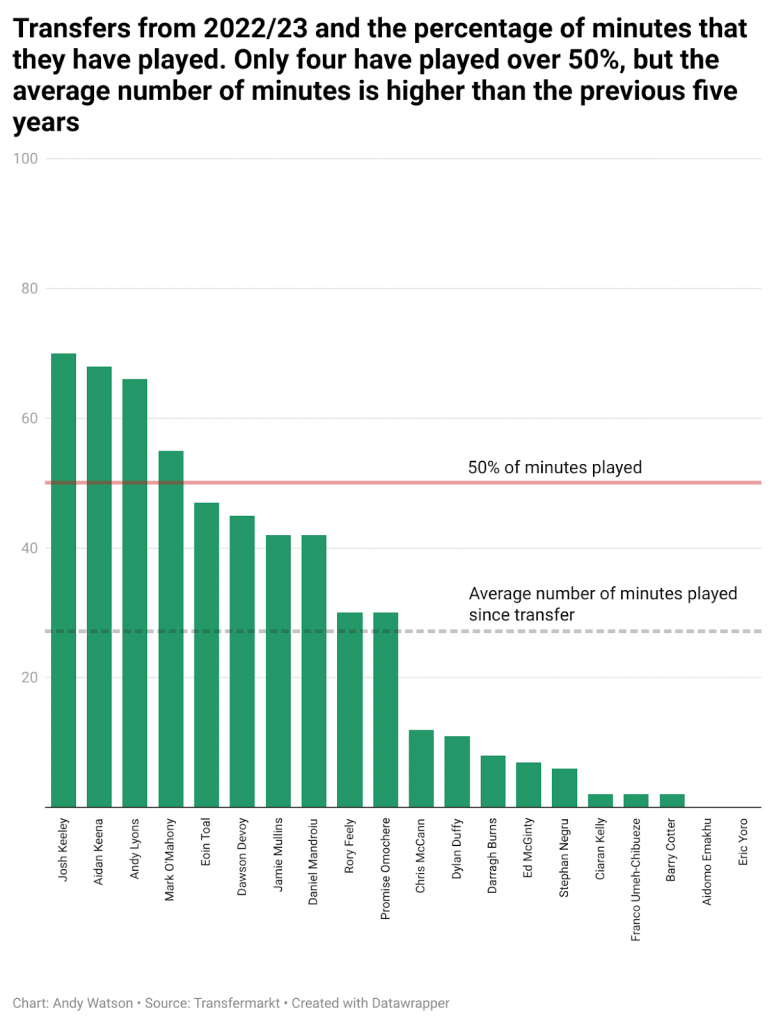
For this chart I have included PL2 minutes as it would have been unfair on the likes of Josh Keeley, Mark O’Mahony, and Jamie Mullins to not include their minutes seeing as they were purchased to play in that league as part of their development.
January signings Aidan Keena, Andy Lyons and Rory Feely have all had good impacts for their new clubs. Eoin Toal has impressed at Bolton, though a summer move up would be a surprise, Dawson Devoy and Danny Mandroiu have also demonstrated that the best LoI talent looks to be able to hold its own in League One given the right circumstances. Only injuries have prevented Promise Omochere from getting even more minutes for Fleetwood too, he has also impressed at League One level.
Indeed, looking at the business from this season it would be fair to say that despite the growth of recruitment, it has been relatively successful. Even players that haven’t played much this season have time and development ahead of them to make an impact at a later date and there are only one or two that look to be in danger of not impacting their clubs at all. A sign that recruitment processes are improving?
The Influence of European Clubs in Ireland
There has also been one other notable effect to the age restrictions. Although England cannot sign 16-18 aged Irish talent, the EU still can. Young Irishmen going out to Germany, Italy, or other top nations was almost unheard of prior to Brexit but is now extremely relevant.
The most instructive examples are Kevin Zefi and Cathal Heffernan. The two 17-year-olds played against each other this season in a derby, except instead of it being a Dublin derby, or even a Manchester one, it was in Milan. Zefi signed for Inter as a 16-year-old from Shamrock Rovers and Heffernan went from Cork City to AC Milan at the same age.
These were transfers that have changed the way that both Irish players and representatives have looked at the Italian market, but also the way that the Italian market looks at Ireland. James Abankwah, a Waterford-born, Longford-raised defender became an Irish export to Italy in 2022, although at (just) 18-years-old he could have moved to England if he wanted to.
However, it was Udinese who showed an interest and Abankwah was more than happy to test himself in a different environment. It appears to have worked out well for him as well, with Abankwah making his Serie A debut this month as a substitute vs Bologna. With Udinese, of course, there is always the route into English football with Watford as part of the Pozzo family group.
With this door now open and clubs/agents looking to exploit this opportunity it will be interesting to see what continues to happen to the brightest Irish talents. Can they be persuaded by English clubs to wait until 18, or will European giants continue to swoop in during that 16-18 window to complete the development of the best Irish products?
Will the Irish recruitment drive continue at this pace?
Joe Riley seemed to think that there would be even more competition in Ireland moving forwards in the next few transfer windows. Indeed, there seems to have been more reports of scouts going over to Ireland to watch players for their EFL clubs.
With the Irish season now beginning to settle down and sample sizes for data getting more reliable for 2023 we are likely to see those visits increase as clubs finalise their targets for summer. With Irish contracts not ending until, typically, the end of November, fees may have to be paid, which is often a stumbling block for EFL clubs, but also contributes towards why fees are often low in Ireland, with less time on contracts to pay off.
There have been a number of examples of positive impacts being made across the EFL by Irish signings made last summer and in January, so there is no reason to suspect that there will be a slowdown at this stage. There should be a warning attached though: is the requisite depth there in such a small league for it to be dredged regularly?
Where youth is concerned, the picture shifts. Ireland continues to produce excellent young talent: Sam Curtis, Tommy Lonergan, Jad Hakiki, James McManus, Justin Ferizaj, and others look to be the next ones off the exciting talent conveyor belt. The question is, will they be picked off by European Union clubs before they reach 18, will they become PL2 signings, or can EFL clubs sneak in to provide this talent a bridge to the top?
Whatever happens, the Irish market seems more vibrant and interesting than it has for some while, an unintended result of Brexit and GBE regulations, and, as ever, smart clubs with strong and intelligent recruitment will be the winners.
Header image: IMAGO / ZUMA Wire

